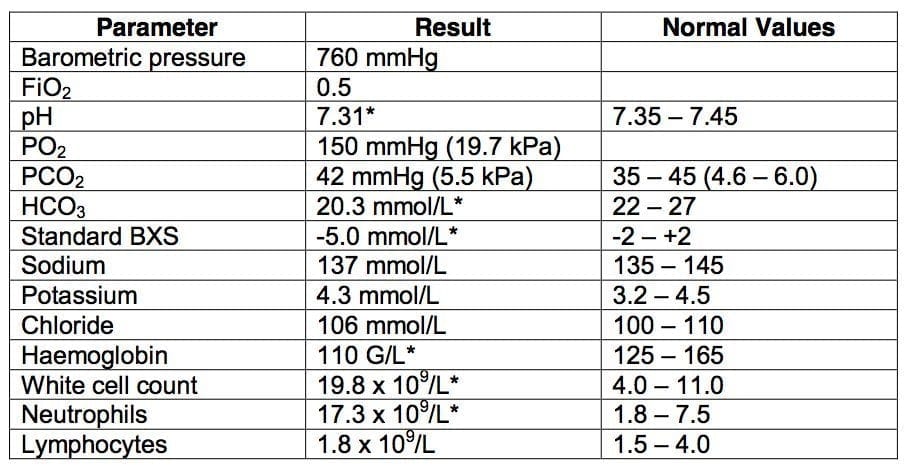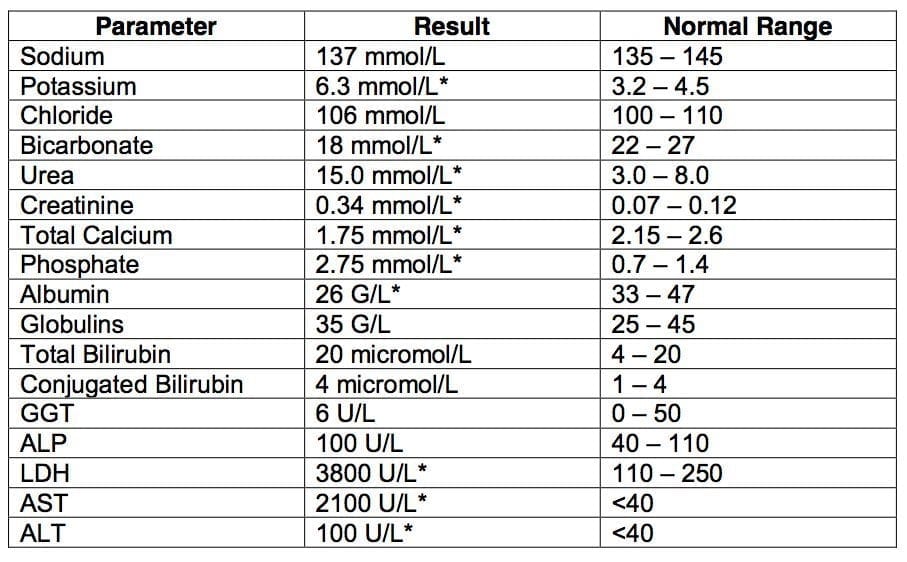CICM SAQ 2012.2 Q6
Questions
Q1. The following blood gases, electrolytes and full blood count relate to a 32-year-old woman post-extubation, following an emergency lower segment Caesarian section at 38 weeks gestation for foetal distress during labour:
- a) Comment on and interpret the arterial blood gases and the acid-base status.
- b) What is the significance of the haemoglobin concentration and white cell count?
Q2. The following biochemical profile is that of a 68-year-old man who has undergone endovascular repair of an abdominal aortic aneurysm that was technically difficult:
- What is the likely cause of this biochemical profile?
Q3. List four possible underlying reasons for the above biochemical profile
Answers
Answer and interpretation
Q1. a) Comment on and interpret the arterial blood gases and the acid-base status.
- Raised A-a gradient of 154 mmHg suggestion shunt and/or V/Q mismatch. Potential explanations are loss of FRC post abdominal surgery, segmental collapse/consolidation or aspiration.
- Acute respiratory acidosis – normal PCO2 for 38 weeks gestation is 30 mmHg with compensatory reduction in HCO3. CO2 retention is possibly due to pain, narcotics and/or sedation from anaesthetic agents
- Normal anion gap
Q1. b) What is the significance of the haemoglobin concentration and white cell count?
- Anaemia and leukocytosis – mild anaemia is physiological in pregnancy.
- Neutrophil leukocytosis is a normal feature during labour and early post-partum.
Q2. What is the likely cause of this biochemical profile?
- Rhabdomyolysis from lower limb ischaemia
Q3. List four possible underlying reasons for the above biochemical profile
- Dehydration
- Steroid therapy or Cushings
- GI bleed
- Protein catabolism
- Decreased muscle mass
- Ruptured bladder

Examination Library
CICM
Chris is an Intensivist and ECMO specialist at The Alfred ICU, where he is Deputy Director (Education). He is a Clinical Adjunct Associate Professor at Monash University, the Lead for the Clinician Educator Incubator programme, and a CICM First Part Examiner.
He is an internationally recognised Clinician Educator with a passion for helping clinicians learn and for improving the clinical performance of individuals and collectives. He was one of the founders of the FOAM movement (Free Open-Access Medical education) has been recognised for his contributions to education with awards from ANZICS, ANZAHPE, and ACEM.
His one great achievement is being the father of three amazing children.
On Bluesky, he is @precordialthump.bsky.social and on the site that Elon has screwed up, he is @precordialthump.
| INTENSIVE | RAGE | Resuscitology | SMACC



